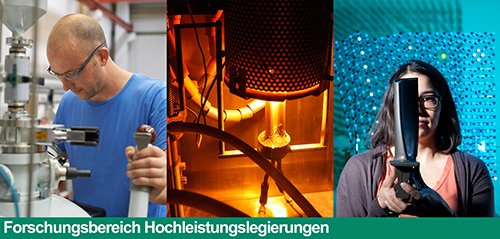Hochleistungslegierungen

Der Begriff Hochleistungslegierungen umfasst eine Vielzahl von Materialsystemen. Üblicherweise wird er für Legierungen verwendet, die extremen Bedingungen trotzen, wie zum Beispiel hohen Temperaturen oder korrosiven Atomsphären, eine außergewöhnliche Kombination von Festigkeit und Duktilität aufweisen, oder andere einzigartige Eigenschaften besitzen, wie zum Beispiel den sogenannten Formgedächtniseffekt. Das Ziel der Gruppe für Hochleistungslegierungen ist es bestehende Materialien zu optimieren und neue Legierungen durch eine systematische Untersuchung der relevanten multidimensionalen Legierungsräume zu entdecken.
Team
Arbeitsgebiete
Publikationen zu diesem Forschungsbereich
Beiträge in Fachzeitschriften
- , , , , :
A Novel Approach for Rapid Material Library Generation Using Laser-Remelting
In: Advanced Engineering Materials 26 (2024), Art.Nr.: 2301316
ISSN: 1438-1656
DOI: 10.1002/adem.202301316 - , , , , , , , :
Experimental Validation of Property Models and Databases for Computational Superalloy Design
In: Advanced Engineering Materials (2024)
ISSN: 1438-1656
DOI: 10.1002/adem.202401051 - , , , , :
Phase field modeling of shearing processes of a dual-lobed γ″|γ′|γ″ coprecipitate
In: Acta Materialia 246 (2023), Art.Nr.: 118693
ISSN: 1359-6454
DOI: 10.1016/j.actamat.2023.118693 - , , , , , , , :
Influence of Cu Addition and Microstructural Configuration on the Creep Resistance and Mechanical Properties of an Fe-Based alpha/alpha '/alpha '' Superalloy
In: Advanced Engineering Materials (2023)
ISSN: 1438-1656
DOI: 10.1002/adem.202201652 - , , , , , , , , :
Influence of the W and Ta content on the High-Temperature Oxidation Resistance of Multinary Co/Ni-Based Superalloys at 1050 °C and 1150 °C
In: High Temperature Corrosion of Materials (2023)
ISSN: 2731-8397
DOI: 10.1007/s11085-023-10183-1 - , , , , , , , , , :
Numerical Design of CoNi-Base Superalloys With Improved Casting Structure
In: Metallurgical and Materials Transactions A-Physical Metallurgy and Materials Science (2022)
ISSN: 1073-5623
DOI: 10.1007/s11661-022-06870-4 - , , , , , , , , , , :
Laser powder bed fusion of FeCoBSiNb-Cu bulk metallic glass composites: Processing, microstructure and mechanical properties
In: Materials Science and Engineering A-Structural Materials Properties Microstructure and Processing 849 (2022), Art.Nr.: 143405
ISSN: 0921-5093
DOI: 10.1016/j.msea.2022.143405 - , , , , :
On stabilizing an α/α′/α″ microstructure in ferritic superalloys
In: Journal of Alloys and Compounds 911 (2022), Art.Nr.: 164996
ISSN: 0925-8388
DOI: 10.1016/j.jallcom.2022.164996 - , , , , , , , :
Quantification of the temperature-dependent evolution of defect structures in a CoNi-base superalloy
In: Acta Materialia 227 (2022), Art.Nr.: 117702
ISSN: 1359-6454
DOI: 10.1016/j.actamat.2022.117702 - , , , , , , :
Microstructural evolution and mechanical properties in Zr–Cu–Al–Nb bulk metallic glass composites prepared by laser metal deposition
In: Intermetallics 140 (2022), Art.Nr.: 107393
ISSN: 0966-9795
DOI: 10.1016/j.intermet.2021.107393 - , , , , :
Miniature mechanical testing of LMD-fabricated compositionally & microstructurally graded γ titanium aluminides
In: Journal of Materials Research (2022)
ISSN: 0884-2914
DOI: 10.1557/s43578-022-00801-0 - , , , , , , , :
Improving the Effectiveness of the Solid-Solution-Strengthening Elements Mo, Re, Ru and W in Single-Crystalline Nickel-Based Superalloys
In: Metals 11 (2021), Art.Nr.: 1707
ISSN: 2075-4701
DOI: 10.3390/met11111707 - , , , , , , :
Thermoelastic properties and γ’-solvus temperatures of single-crystal Ni-base superalloys
In: Journal of Materials Science (2021)
ISSN: 0022-2461
DOI: 10.1007/s10853-020-05628-w - , , , , , , , :
Yielding behavior of a single-crystalline γ'-strengthened Co-Ti-Cr superalloy
In: Scripta Materialia 200 (2021), S. 113928
ISSN: 1359-6462
DOI: 10.1016/j.scriptamat.2021.113928 - , , , , :
Impact of the Co/Ni-Ratio on Microstructure, Thermophysical Properties and Creep Performance of Multi-Component γ′-Strengthened Superalloys
In: Crystals 10 (2020), S. 1058
ISSN: 2073-4352
DOI: 10.3390/cryst10111058 - , , , , , , , :
Preparation of Fe-Co-B-Si-Nb bulk metallic glasses by laser powder bed fusion: Microstructure and properties
In: Materials Characterization 162 (2020), Art.Nr.: 110206
ISSN: 1044-5803
DOI: 10.1016/j.matchar.2020.110206 - , , , , , :
Additively manufactured Raney-type Copper catalyst for methanol synthesis
In: Catalysis: Science and Technology 10 (2020), S. 164-168
ISSN: 2044-4753
DOI: 10.1039/C9CY01657K - , , , , , , :
Growth and coarsening kinetics of gamma prime precipitates in CMSX-4 under simulated additive manufacturing conditions
In: Acta Materialia (2019)
ISSN: 1359-6454
DOI: 10.1016/j.actamat.2019.08.049 - , , , , , , :
MultOpt++: a fast regression-based model for the constraint violation fraction due to composition uncertainties
In: Modelling and Simulation in Materials Science and Engineering 27 (2019)
ISSN: 0965-0393
DOI: 10.1088/1361-651X/aaf01e - , , , , , , , :
MultOpt++: a fast regression-based model for the development of compositions with high robustness against scatter of element concentrations
In: Modelling and Simulation in Materials Science and Engineering 27 (2019)
ISSN: 0965-0393
DOI: 10.1088/1361-651X/aaf0b8 - , , , , , , , :
Effects of Solid Solution Strengthening Elements Mo, Re, Ru, and W on Transition Temperatures in Nickel-Based Superalloys with High γ′-Volume Fraction: Comparison of Experiment and CALPHAD Calculations
In: Metallurgical and Materials Transactions A-Physical Metallurgy and Materials Science (2018)
ISSN: 1073-5623
DOI: 10.1007/s11661-018-4730-0 - , , , , , :
On the Influence of Ta and Ti on Heat-Treatability and γ/γ'-Partitioning of High W Containing Re-Free Nickel-Based Superalloys
In: Advanced Engineering Materials (2017)
ISSN: 1438-1656
DOI: 10.1002/adem.201700150 - , , , , , , , , :
Diffusion of solutes in fcc Cobalt investigated by diffusion couples and first principles kinetic Monte Carlo
In: Acta Materialia 106 (2016), S. 304-312
ISSN: 1359-6454
DOI: 10.1016/j.actamat.2016.01.028 - , , , , , , :
Improved creep strength of nickel-base superalloys by optimized γ/γ′ partitioning behavior of solid solution strengthening elements
In: Materials Science and Engineering A-Structural Materials Properties Microstructure and Processing 676 (2016), S. 411-420
ISSN: 0921-5093
DOI: 10.1016/j.msea.2016.08.121 - , , , , , , , , , , :
Effect of ruthenium on the precipitation of topologically close packed phases in Ni-based superalloys of 3rd and 4th generation
In: Acta Materialia 95 (2015), S. 274-283
ISSN: 1359-6454
DOI: 10.1016/j.actamat.2015.05.033 - , , , , , , , :
Effects of Ru on elemental partitioning and precipitation of topologically close-packed phases in Ni-based superalloys
In: Scripta Materialia 101 (2015), S. 44-47
ISSN: 1359-6462
DOI: 10.1016/j.scriptamat.2015.01.014 - , , , , :
Single-crystal nickel-based superalloys developed by numerical multi-criteria optimization techniques: Design based on thermodynamic calculations and experimental validation
In: Modelling and Simulation in Materials Science and Engineering 23 (2015), Art.Nr.: 035004
ISSN: 1361-651X
DOI: 10.1088/0965-0393/23/3/035004 - , , , , , :
On the Thermodynamics and Kinetics of TCP Phase Precipitation in Re- and Ru- Containing Ni-base Superalloys
In: Advanced Engineering Materials 17 (2015), S. 1127-1133
ISSN: 1438-1656
DOI: 10.1002/adem.201500173 - , , , , :
Optimization of the Homogenization Heat Treatment of Nickel-Based Superalloys Based on Phase-Field Simulations: Numerical Methods and Experimental Validation
In: Metallurgical and Materials Transactions A-Physical Metallurgy and Materials Science 46 (2015), S. 5842-5855
ISSN: 1073-5623
DOI: 10.1007/s11661-015-3130-y - , :
Fast interpolation algorithm for the calculation of thermodynamic property maps of microstructures
In: Modelling and Simulation in Materials Science and Engineering 22 (2014), S. 1-19
ISSN: 1361-651X
DOI: 10.1088/0965-0393/22/8/085002 - , , , , :
The Three-dimensional morphology of topologically close packed phases in a high rhenium containing nickel based superalloy
In: Advanced Engineering Materials 16 (2014), S. 171-175
ISSN: 1438-1656
DOI: 10.1002/adem.201300198 - , , , :
Discontinuous precipitation and phase stability in Re- and Ru-containing nickel-base superalloys
In: Metallurgical and Materials Transactions A-Physical Metallurgy and Materials Science 43 (2012), S. 10-19
ISSN: 1073-5623
DOI: 10.1007/s11661-011-0833-6 - , , , :
The effect of Re and Ru on γ/γ′ microstructure, γ-solid solution strengthening and creep strength in nickel-base superalloys
In: Materials Science and Engineering A-Structural Materials Properties Microstructure and Processing 528 (2011), S. 3435-3444
ISSN: 0921-5093
DOI: 10.1016/j.msea.2011.01.023 - , , :
Creep rupture strength of Re and Ru containing experimental nickel-base superalloys
In: Advanced Materials Research 278 (2011), S. 339-344
ISSN: 1022-6680
DOI: 10.4028/www.scientific.net/AMR.278.339 - , , , , :
Reasons for the enhanced phase stability of Ru-containing nickel-based superalloys
In: Acta Materialia 59 (2011), S. 6563-6573
ISSN: 1359-6454
DOI: 10.1016/j.actamat.2011.07.002 - , :
Numerical modelling of precipitation of topologically close-packed phases in nickel-base superalloys
In: Acta Materialia 59 (2011), S. 317-327
ISSN: 1359-6454
DOI: 10.1016/j.actamat.2010.09.035 - , , :
Modeling of precipitation kinetics of TCP-phases in single crystal nickel-base superalloys
In: Advanced Materials Research 278 (2011), S. 180-185
ISSN: 1022-6680
DOI: 10.4028/www.scientific.net/AMR.278.180 - , , , , :
Investigation of the final stages of solidification and eutectic phase formation in Re and Ru containing nickel-base superalloys
In: Journal of Crystal Growth 312 (2010), S. 2137-2144
ISSN: 0022-0248
DOI: 10.1016/j.jcrysgro.2010.03.041 - , , :
Solidification Characteristics and Segregation Behavior of Nickel-Base Superalloys in Dependence on Different Rhenium and Ruthenium Contents
In: Metallurgical and Materials Transactions A-Physical Metallurgy and Materials Science 41A (2010), S. 202-211
ISSN: 1073-5623
DOI: 10.1007/s11661-009-0076-y - , , , , , :
Verification of a commercial CALPHAD database for Re and Ru containing nickel-base superalloys
In: Defect and Diffusion Forum 289-292 (2009), S. 101-108
ISSN: 1012-0386
DOI: 10.4028/www.scientific.net/DDF.289-292.101 - , , , , :
Influence of topologically closed packed phase formation on creep rupture life of directionally solidified nickel-base superalloys
In: Metallurgical and Materials Transactions A-Physical Metallurgy and Materials Science 37 (2006), S. 405-410
ISSN: 1073-5623
DOI: 10.1007/s11661-006-0011-4 - , , , :
Partitioning of Re between γ and γ′ phase in nickel-base superalloys
In: Scripta Materialia 52 (2005), S. 141-145
ISSN: 1359-6462
DOI: 10.1016/j.scriptamat.2004.09.013
Beiträge bei Tagungen
- , , , , , , , , , , :
On the Influence of Alloy Composition on Creep Behavior of Ni-Based Single-Crystal Superalloys (SXs)
14th International Symposium on Superalloys, Superalloys 2021 (Seven Springs, PA, 12. September 2021 - 16. September 2021)
In: Sammy Tin, Mark Hardy, Justin Clews, Jonathan Cormier, Qiang Feng, John Marcin, Chris O'Brien, Akane Suzuki (Hrsg.): Minerals, Metals and Materials Series 2020
DOI: 10.1007/978-3-030-51834-9_6 - , , , , , :
Development of a low-density rhenium-free single crystal nickel-based superalloy by application of numerical multi-criteria optimization using thermodynamic calculations
13th International Symposium on Superalloys, SUPERALLOYS 2016 (Seven Springs, 11. September 2016 - 15. September 2016)
In: M. Hardy, E. Huron, U. Glatzel, B. Griffin, B. Lewis, C. Rae, V. Seetharaman, S. Tin (Hrsg.): Superalloys 2016: Proceedings of the 13th Intenational Symposium of Superalloys 2016
DOI: 10.1002/9781119075646.ch4 - , , , , :
Discussing the effect of gamma prime coarsening on high temperature low stress creep deformation with respect to the role of refractory elements
13th International Symposium on Superalloys, SUPERALLOYS 2016 (Seven Springs, 11. September 2016 - 15. September 2016)
In: M. Hardy, E. Huron, U. Glatzel, B. Griffin, B. Lewis, C. Rae, V. Seetharaman, S. Tin (Hrsg.): Superalloys 2016: Proceedings of the 13th Intenational Symposium of Superalloys 2016
DOI: 10.1002/9781119075646.ch70 - , , :
The effect of Ru on precipitation of topologically close packed phases in Re-containing Ni base superalloys: Quantitative FIB-SEM investigation and 3D image modeling
2nd European Symposium on Superalloys and Their Applications, EUROSUPERALLOYS 2014 (Giens)
DOI: 10.1051/matecconf/20141409001 - , :
Influence of Ruthenium on topologically closed packed phase precipitation in single-crystal Ni-based superalloys: numerical experiments and validation
112th International Symposium on Superalloys, SUPERALLOYS 2012 (Seven Springs, 9. September 2012 - 13. September 2012)
In: E. S. Huron, R. C. Reed, M. C. Hardy, M. J. Mills, R. E. Montero, P. Dolabella Portella, J. Telesman (Hrsg.): Superalloys 2012: Proceedings of the 12th Intenational Symposium of Superalloys 2012 - , , , , , , :
Development of a new alloy for directional solidification of large industrial gas turbine blades
SUPERALLOYS 2004 - Tenth International Symposium on Superalloys (Champion, PA) - , :
Influence of solidification conditions on TCP phase formation, casting porosity and high temperature mechanical properties in a Re-containing nickel-base superalloy with columnar grain structure
10th International Symposium on Superalloys, SUPERALLOYS 2004 (Seven Springs, 19. September 2004 - 23. September 2004)
In: K. Green, H. Harada, T.E. Howson, T.M. Pollock, R.C. Reed, J.J. Schirra, S. Walston (Hrsg.): Superalloys 2004: Proceedings of the 10th Intenational Symposium of Superalloys 2004
DOI: 10.7449/2004/Superalloys_2004_713_718 - , , , , :
CBED-Measurement of Residual Internal Strains in the Neighbourhood of TCP-Phases in Ni-Base Superalloys
9th International Symposium on Superalloys, SUPERALLOYS 2000 (Seven Springs, 17. September 2000 - 21. September 2000)
In: K. Green, T. M. Pollock, R. Kissinger, R.R. Bowman, K.A. Green, M. McLean, S. Olson, J.J. Schirra (Hrsg.): Superalloys 2000: Proceedings of the 9th Intenational Symposium of Superalloys 2000
Abschlussarbeiten
- :
Laser-based additive manufacturing of bulk metallic glass-forming alloys: Processing, microstructure and properties (Dissertation, 2022) - :
Bedeutung der Mischkristallhärter für die Kriechbeständigkeit Re-freier Nickelbasis-Einkristall-Legierungen (Dissertation, 2021) - :
Precepetation of Topologically Close Packed Phases in Ni-base Superalloys - the Effect of Re and Ru (Dissertation, 2016) - :
Designkriterien für rheniumreduzierte Nickelbasis-Einkristalllegierungen: Identifikation und rechnergestützte Umsetzung (Dissertation, 2016) - :
Auswirkungen der Legierungszusammensetzung auf die Morphologie und die Festigkeit des Dendritennetzwerkes bei der gerichteten Erstarrung von Nickelbasis-Superlegierungen (Dissertation, 2013) - :
Auswirkungen von Rhenium und Ruthenium auf die Mikrostruktur und Hochtemperaturfestigkeit von Nickel-Basis Superlegierungen unter Berücksichtigung der Phasenstabilität (Dissertation, 2011) - :
Mathematische Modellierung der Ausscheidung von Sprödphasen in komplexen rutheniumhaltigen Nickelbasis-Superlegierungen (Dissertation, 2010) - :
Erstarrungsmikrostruktur und Hochtemperatureigenschaften rheniumhaltiger, stängelkristalliner Nickel-Basis-Superlegierungen (Dissertation, 2002)
Projekte zu diesem Forschungsbereich
SFB/TRR 103 (C07): Multikriterielle Berechnung optimaler Zusammensetzungen einkristalliner Superlegierungen
A new numerical tool will be explored that supports the experimental alloy developer in defining new compositions with potential for high strength. Starting with a composition space that is defined by the developer based on his metallurgical experience and his design goals, the numerical tool will propose the most promising compositions. The research program will on the one hand address open questions regarding the mathematical optimization in this application and on the other hand new models for predicting the relevant material properties.
Iron aluminides and hierarchical-precipitate-strengthened ferritic superalloys
It is worked on novel hierarchical FeAl-based precipitate-strengthened alloys for high-temperature structural applications. Some of them show very unique hierarchical microstructure with L21 precipitates within B2 precipitates within a bcc matrix. This exciting group of materials resembles a promising low-cost alternative to Ni-superalloys and Ti-based alloys under specific conditions. A potential application for these alloys ultra-supercritical power plants with service temperatures…
Cu-based shape memory alloys and bulk-metallic glasses
In this project two different but equally exciting material systems are being investigated:
Development of high temperature Cu-Al-Ni-X shape memory alloys (SMAs)
Compared to commercially available Ni-Ti SMAs, Cu-Al-Ni-X SMAs possess a slightly higher transformation temperature above 100 °C and exhibit a lower production cost. However, poor mechanical properties caused by their typically coarse grain size and anisotropy severely limit their worldwide application. Therefore, …






